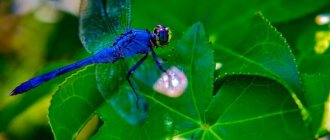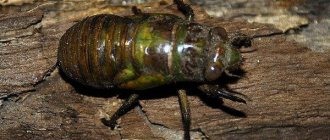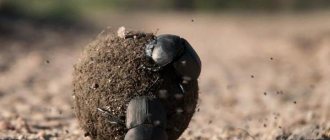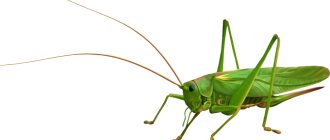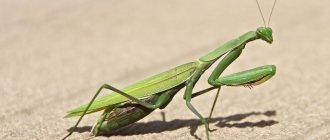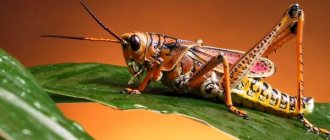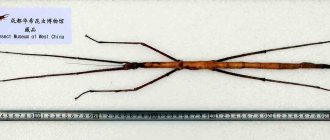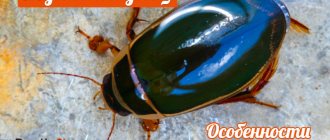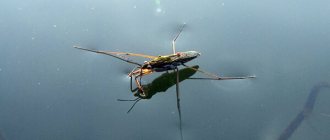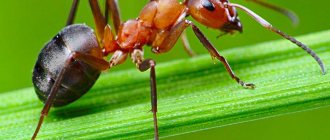Biological features
Based on the body structure of insects, scientists have identified two groups: homoptera dragonflies, which belong to the suborder Anisoptera, and homoptera dragonflies, representatives of the suborder Zygoptera. The first of them are faster and have slightly larger sizes. The insect has massive jaws and large eyes, consisting of a huge number (20-30 thousand) ocelli.
The eyes occupy most of the head of the unequal-winged dragonfly - they converge at the top, which gives the insect the opportunity to see almost everything around. Homoptera dragonflies have smaller eyes, and they are located at some distance from each other. Therefore, the head of Zygoptera is similar in shape to a hammer.
Visual acuity in both groups was excellent. In some insects, the head can turn, and the viewing angle changes. The dragonfly is endowed with inconspicuous antennae. Its body, unlike other groups of insects, is sloping. Because of this, its lower section is slightly pushed forward, and the upper section, where the wings are located, is pushed back. One pair of wings is located on the body above the second, and two pairs of legs are located directly behind the head. This arrangement of limbs does not allow insects to walk, but this body structure makes it possible to deftly hold on to any base and firmly hold prey.
Big eyes? No, tiny eyes
If you examine the eyes of a dragonfly under a microscope, you will notice that they are different in size: the facets at the top are larger, and the ones at the bottom are smaller. In addition, scientists have found that the upper facets see only blue, and those located below see other shades. From the dragonfly's point of view, this is very convenient. After all, insects flying against the sky or below are more noticeable to the hunter. The dragonfly also sees ultraviolet light. Scientists have found that another feature of the compound eye is its ability to distinguish the flickering of light. The insects that the dragonfly feeds on quickly flap their wings, and the hunter sees this and attacks.
Types of dragonflies
Today, scientists have described more than 6,000 species of dragonflies, of which about 172, forming 52 genera, live in the CIS countries.
- Scolopendra
- 32 facts about tigers
- Weasel
- Whale shark
- 34 facts about raccoons
- Maned wolf
In the classification of dragonflies, there are 3 suborders:
- heteroptera dragonflies (lat. Anisoptera);
- homoptera dragonflies (lat. Zygoptera);
- аnisozygoptera (combines the main characters of previous suborders).
Dragonflies
A characteristic feature of the suborder of heteroptera dragonflies is the perpendicular arrangement of the wings at rest and the difference in their size (the front wings of the dragonfly are much larger than the hind wings). The most famous representatives of heteroptera dragonflies are:
- Dragonfly watchman-emperor or watchman-overlord (lat. Anax imperator) , belonging to the rocker family (lat. Aeshnidae) is a large insect with a wingspan of up to 11 cm and a body length of about 8 cm. The chest is green in color with black stripes. Males and females differ in the color of their wings and abdomen. Female dragonflies have golden-yellow wings and bluish-green bellies with large reddish-brown spots. The male dragonfly of this species is distinguished by colorless wings and a blue belly, on which dark brown spots are visible. Dragonflies appear in mid-June; the flight period lasts 1.5 months. They prefer to flutter near stagnant or low-flowing bodies of water. The Emperor Watcher is considered one of the largest dragonflies in Russia.
- Dragonfly Cordulegaster boltonii , which is the only representative of the Cordulegasteridae family (Latin Cordulegaster boltonii). The dimensions of this type of dragonfly are: body length up to 9 cm, wingspan about 10.5 cm. Oblique and transverse yellow stripes run along the abdomen and chest. The transparent wings of the dragonfly have black veins. Throughout the summer, they fly on the edges and forest clearings, near lakes and rivers with calm currents.
- Metallic dragonfly (lat. Somatochlora metallika) , part of the family of grandmothers or patrolmen (lat. Corduliidae). A small insect, the body size of which does not exceed 4.5 cm, and the wingspan is only 3.5-3.8 cm. The general color of the chest and body is green with a metallic sheen. Yellow spots are visible on the first and third segments of the abdomen, and a thin yellow stripe runs along the forehead. The leading edge of the female dragonfly's wings has the same shade. The flight period of this species of dragonfly lasts from late May to mid-autumn. Metal headstocks are found near bodies of water with stagnant or low-flowing water.
- The common dragonfly (lat. Gomphus vulgatissimus) belongs to the family Dedki or Rivermen (lat. Gomphidae). A rather small insect with a wingspan of about 3 cm and an abdomen length of up to 3.7 cm. The abdomen of the dragonfly is painted black with yellow spots located on the sides and a thin longitudinal stripe of the same color running across the top of the entire body. The lifespan of dragonflies of this species does not exceed 30 days. The dragonfly lives on forest edges and clearings near rivers, reservoirs or canals with a sandy and muddy bottom.
- The common dragonfly (lat. Sympetrum vulgatum) is a typical representative of the large family of true dragonflies (lat. Libellulidae). The color of insects can be yellow, brown or reddish and changes with age. The length of the abdomen of the common dragonfly is about 2.8 cm, the wingspan is up to 6 cm.
Color is a clear indicator of gender: in males, the lateral parts of the chest and the flattened, expanded abdomen are red with black wide stripes; in females, the body is brown, and the lateral surface of the chest is yellow-brown. Black stripes cross the entire body.
Dragonflies fly near grassy swamps or ponds heavily overgrown with vegetation.
Homoptera dragonflies
In representatives of the suborder Homoptera dragonflies, both pairs of wings are the same size, and when resting from flying, insects fold their wings and hold them in a vertical position above the body. The flight speed of these dragonflies is much lower than that of heteroptera.
The most “bright” representatives of the suborder are:
- Dragonfly Beauty girl or dark-winged beauty (lat. Calopteryx virgo) , part of the Beauty family (lat. Calopteryg idae). These are medium-sized insects with a wingspan of up to 7 cm and a body length of about 5 cm. The color of the wings of males is bluish-blue, and the body color is greenish-blue with a metallic tint. Female dragonflies are characterized by transparent wings riddled with brown veins and a bronze-green body color. The beautiful female dragonfly lives along the vegetated banks of streams and rivers with a slow flow. The flight period begins in July and ends at the end of September. These dragonflies live in Europe, Siberia, the Far East, China, Japan, Mongolia, and Korea.
- Southern Arrow dragonfly (lat. Coenagrion mercuriale) . Quite small dragonflies with a body length not exceeding 3.5 cm and a wingspan of about 4.5 cm. The male dragonfly has a bright blue body color with a dark heart-shaped spot. Females can vary in color from green to red-brown with black spots on each abdominal segment. You can see these insects in the air both in early May and mid-September. Dragonflies fly near large bodies of water or slow-flowing rivers.
- The dragonfly Lyutka-dryad (lat. Lestes dryas) is a representative of the Lyutka family (lat. Lestidae). A small dragonfly with a body length of about 3.5-4 cm and a wingspan of up to 3-4 cm. The color of males and females is the same - bronze-green on top, and with a yellow tint on the sides. The edges of the transparent wings are framed by a brown border. These dragonflies begin to fly from the beginning of July to the first days of September. The lute-dryad dragonfly lives near warm and shallow, sometimes drying up reservoirs with abundant aquatic vegetation.
- Megaloprepus caerulatus is the largest dragonfly in the world. Individuals of this species can reach 10 cm in length and have a wingspan of up to 19 cm. Adult dragonflies feed on spiders, grabbing them in flight directly from the catching web. The wings of these insects are transparent with brown veins, with a wide blue vertical stripe at the tip of the wing. This stripe contains pale blue round spots, sometimes merging into a single stripe. The color of the wide stripe on the underside of the dragonfly's wings is black. The first and second pairs of wings are almost identical in size and structure. The largest dragonfly in the world lives in humid and damp forests in Central and South America.
Compound or compound eyes. Compounded eyes: how do they differ from simple eyes? Compound eyes of a fly
Even in distant childhood, many of us asked such seemingly trivial questions about insects, such as: how many eyes does an ordinary fly have, why a spider weaves a web, and why a wasp can bite.
The science of entomology has answers to almost any of them, but today we will call on the knowledge of researchers of nature and behavior in order to understand the question of what the visual system of this species is.
In this article we will analyze how a fly sees and why this annoying insect is so difficult to swat with a fly swatter or to catch with your palm on a wall.
Room dweller
The housefly or housefly belongs to the family of true flies. And even though the topic of our review concerns all species without exception, for convenience we will allow ourselves to consider the entire family using the example of this very familiar species of domestic parasites.
The common house fly is a very unremarkable insect in appearance. It has a grey-black body coloration, with some hints of yellow on the lower abdomen. The length of an adult individual rarely exceeds 1 cm. The insect has two pairs of wings and compound eyes.
Compound eyes - what's the point?
The fly's visual system includes two large eyes located at the edges of the head. Each of them has a complex structure and consists of many small hexagonal facets, hence the name of this type of vision as faceted.
In total, the fly eye has more than 3.5 thousand of these microscopic components in its structure. And each of them is capable of capturing only a tiny part of the overall image, transmitting information about the resulting mini-picture to the brain, which puts all the puzzles of this picture together.
If you compare facet vision and binocular vision, which a person has, for example, you can quickly see that the purpose and properties of each are diametrically opposed.
More developed animals tend to concentrate their vision on a certain narrow area or on a specific object. For insects, it is important not so much to see a specific object as to quickly navigate in space and notice the approach of danger.
Why is she so difficult to catch?
This pest is really very difficult to take by surprise. The reason is not only the increased reaction of the insect in comparison with a slow person and the ability to take off almost instantly. Mainly, such a high level of reaction is due to the timely perception by the brain of this insect of changes and movements within the viewing radius of its eyes.
A fly's vision allows it to see almost 360 degrees. This type of vision is also called panoramic. That is, each eye provides a 180-degree view. It is almost impossible to take this pest by surprise, even if you approach it from behind. The eyes of this insect allow you to control the entire space around it, thereby providing one hundred percent all-round visual defense.
There is another interesting feature of the fly’s visual perception of the color palette. After all, almost all species perceive differently certain colors familiar to our eyes. Some of them cannot be distinguished by insects at all, others look different to them, in different colors.
By the way, in addition to two compound eyes, the fly has three more simple eyes. They are located in the space between the facets, on the frontal area of the head. Unlike compound eyes, these three are used by insects to recognize an object in the immediate vicinity.
Thus, to the question of how many eyes does an ordinary fly have, we can now safely answer – 5. Two complex facet eyes, divided into thousands of ommatidia (facets) and designed for the most extensive control over changes in the environment around it, and three simple eyes , allowing, as they say, sharpening.
View of the world
We have already said that flies are color blind, and they either do not distinguish all colors, or they see objects familiar to us in other color tones. This species is also able to distinguish ultraviolet light.
It should also be said that, despite the uniqueness of their vision, these pests practically cannot see in the dark. At night, the fly sleeps because its eyes do not allow this insect to hunt in the dark.
And these pests also tend to perceive well only smaller and moving objects. An insect cannot distinguish objects as large as a person, for example. For a fly, it is nothing more than another part of the interior of the environment.
But the approach of a hand to an insect is perfectly detected by its eyes and promptly gives the necessary signal to the brain. Just like seeing any other rapidly approaching danger, it will not be difficult for these sneakers, thanks to the complex and reliable tracking system that nature has provided them with.
Conclusion
So we analyzed what the world looks like through the eyes of a fly. Now we know that these ubiquitous pests, like all insects, have an amazing visual apparatus, which allows them not to lose vigilance, and to maintain an all-round observation defense at one hundred percent during daylight hours.
The common fly's vision resembles a complex tracking system, including thousands of mini-surveillance cameras, each of which provides the insect with timely information about what is happening in the immediate range.
At high magnification, the insect's eye looks like a fine lattice.
This is because the insect's eye is made up of many small "eyes" called facets. Insect eyes are called compound
.
The tiny facet eye is called an ommatidium
.
The ommatidium looks like a long narrow cone, the base of which is a lens shaped like a hexagon. Hence the name of the compound eye: facette
“edge”
in French .
A tuft of ommatidia makes up the complex, round, insect eye.
Each ommatidia has a very limited field of view: the visual angle of ommatidia in the central part of the eye is only about 1°, and at the edges of the eye - up to 3°.
The ommatidium “sees” only that tiny section of the object in front of its eyes at which it is “aimed”, that is, where the extension of its axis is directed.
But since the ommatidia are closely adjacent to each other, and their axes in the round eye diverge in a radial manner, the entire compound eye covers the object as a whole. Moreover, the image of the object turns out to be mosaic, that is, made up of separate pieces.
The number of ommatidia in the eye varies from insect to insect. A worker ant has only about 100 ommatidia in its eye, a housefly has about 4,000, a worker bee has 5,000, butterflies have up to 17,000, and dragonflies have up to 30,000! Thus, the ant has very mediocre vision, while the dragonfly's huge eyes - two iridescent hemispheres - provide the maximum field of vision.
Due to the fact that the optical axes of ommatidia diverge at angles of 1-6°, the clarity of the image of insects is not very high: they do not distinguish small details. In addition, most insects are myopic: they see surrounding objects at a distance of only a few meters.
But compound eyes are excellent at distinguishing flickering (blinking) light with a frequency of up to 250–300 hertz (for humans, the limiting frequency is about 50 hertz). The eyes of insects are able to determine the intensity of the light flux (brightness), and in addition, they have a unique ability: they can determine the plane of polarization of light.
This ability helps them navigate when the sun is not visible in the sky.
Insects distinguish colors, but not at all like we do. For example, bees “do not know” the color red and do not distinguish it from black, but they perceive ultraviolet rays, invisible to us, which are located at the opposite end of the spectrum. Ultraviolet radiation is also detected by some butterflies, ants and other insects. By the way, it is the blindness of pollinating insects to the red color that explains the curious fact that among our wild flora there are no plants with scarlet flowers.
Light coming from the sun is not polarized, that is, its photons have an arbitrary orientation. However, when passing through the atmosphere, light is polarized as a result of scattering by air molecules, and the plane of its polarization is always directed towards the sun
By the way
In addition to compound eyes, insects have three more simple ocelli with a diameter of 0.03-0.5 mm, which are located in the form of a triangle on the fronto-parietal surface of the head. These eyes are not suitable for distinguishing objects and are needed for a completely different purpose.
They measure the average level of illumination, which is used as a reference point (“zero signal”) when processing visual signals. If you seal these eyes of an insect, it retains the ability to spatially orientate itself, but will only be able to fly in brighter light than usual.
The reason for this is that the sealed eyes take the black field as the “average level” and thereby give the compound eyes a wider range of illumination, and this, accordingly, reduces their sensitivity.
show all
In higher insects, the organs of vision are not identical in structure. On the forehead or on them there are three simple ones (in the middle - , on the sides of it - lateral), and on the sides there are two complex compound eyes. They are found in adult insects, as well as in insects, and transmit most of the visual information received.
General structure of the eyes
Most insects have eyes, and only a relatively small number of taxa do not. For example, they are not present in some primitive species, as well as in the wandering Ection ants. In most cases, the eyes are presented as two separate structures, however, for example, in dragonflies they are so large that they converge into a single structure on the eye.
Source: https://csgohap.ru/slozhnye-ili-fasetochnye-glaza-glaza-fasetochnye-chem/
Character and lifestyle of the dragonfly
Dragonflies lead a solitary lifestyle, preferring to hunt on their own. Thanks to its specific wing structure, a dragonfly can either hover in the air, making an instant stop, or fly over vast distances, covering several hundred kilometers without rest.
During landing, the dragonfly does not fold its wings, like many other insects, but always leaves them in a straightened state. The main peak of activity occurs during daylight hours, during which dragonflies fly in search of prey. During hot hours, they can be observed in huge numbers along the banks of reservoirs and above forest edges.
The flight of the dragonfly is characterized by noiselessness, thanks to which the dragonfly can unnoticed approach its prey. They can make intricate turns in the air, do somersaults and even fly backwards. Thanks to this ability, dragonflies can easily escape from predators pursuing them.
How many eyes does a dragonfly have?
From ICH18I
From
Aug 26, 2017
1
Page 1 of 4
How many eyes does a dragonfly have?
It’s probably happened to you more than once to walk through the forest on a warm summer day. Clouds like huge sails float in the blue sky, mighty pines with golden-red bark sway in the wind, and flowers flash at the edge of the forest. You are alone, there is no one around. So no one? After all, thousands of eyes are watching your every move from the foliage, from the grass, and even from the sky.
A swallow glides in the sky. She sees you - but doesn't pay attention to you. She is afraid not of those who walk, but of those who fly. You are not scary for her.
A filly sits in the grass. I saw you, got scared, jumped and flew, flapping my wings. She has many enemies, so she is afraid: what if you eat her? And if a horsefly notices you with its iridescent eyes, it will not run away, but will try to stick its sharp proboscis into your skin. You are prey for the horsefly.
Many different animals live on earth, and each lives in its own way and sees in its own way. Let's take a closer look at them and see what kind of eyes they have?
Whose eyes are binoculars
I was walking through a meadow and suddenly noticed that high above the grass, its wings fluttering, a bird was hanging in one place. Who could it be? I looked through my binoculars and saw a small kestrel falcon. One could clearly see the short and curved beak, just like an eagle’s, the orange chest with small dark specks, and the clawed paws. The kestrel looked down carefully and suddenly, noticing something, fell like a stone into the grass.
One moment - and in her claws there was a mouse, carelessly peeking out of the hole. How could the bird notice its tiny prey from afar? The fact is that many birds of prey - eagles, hawks, falcons - have surprisingly acute vision.
From a distance, they see every bush and every hole as clearly and clearly as a person sees them through binoculars. So the kestrel notices the mouse tens of meters away. And huge vulture birds look out for their prey, dead animals, from the very skies. Vultures fly so high that they are almost invisible from the ground, but they themselves see everything on the ground.
Who only sees up close
You can see a lot of interesting things if you lie motionless in the grass and look at it through a magnifying glass. Blades of grass seem like trees, an ant looks like a terrible monster in shiny armor.
And if you look into the distance through a magnifying glass, you can’t see anything, everything blurs. One day I saw through a magnifying glass that a furry spider was hiding behind a stone. He sits and looks around with all his eyes, and spiders have quite a few of them - as many as eight.
Six little ones are looking around, and two huge ones, like headlights, are looking forward, right at me. He's about to throw himself!
I removed the magnifying glass and saw that he was very tiny, this little spider, he was smaller than a pea. And he doesn’t look at me at all, but at the fly that sat next to him. Bent down and jump! She didn’t even have time to move.
These spiders do not weave webs; they ambush their prey - they are called jumpers. And although they see well, they don’t see far, about ten centimeters. Everything that comes next is like a fog for them. But the snail is crawling - where are its eyes? In front, four stems stick out like horns.
The two lower ones are tentacles, and at the tips of the upper ones there is an eye. If you need to take a closer look at a leaf, the snail will bend the upper stems with its eyes to it and look at it as if through a magnifying glass. Its eyes are simple, they can only see up close, but they will notice what the snail needs.
Try to reach out your hand to the snail - it will immediately pull in the stems and hide in the house.
Previous tale
How a merchant wanted to stop the sun (Udmurt)
Next tale
The shrewd poor man
Source: https://glazastik.net/raznoe/skolko-glaz-u-strekozy.html
What do dragonflies eat?
By the nature of their feeding, dragonflies are typical predators that catch their prey on the fly. Each individual has its own hunting grounds, which they zealously defend from strangers and, if necessary, fight for them. The main food of dragonflies is flies, mosquitoes, moths and other small flying insects. Large individuals are capable of eating small fish, spiders and frogs.
Dragonfly larvae (naiads) feed on young fish, small aquatic insects, crustaceans, and larvae of flies and mosquitoes. This diet is determined by the aquatic habitat. In addition, they clean the reservoir from decaying remains of animal and plant origin.
Fact #5: To make the perfect kill, dragonflies calculate their speed.
The dynamics of capturing a prey in the air are so complex, as if it were carried out not by an insect, but by an animal with a complex nervous system, for example, a seagull or even a human. When going to intercept, a dragonfly moves at its own speed, but it is very difficult to predict where it will end up. When researchers began studying dragonflies in 1999, they discovered that instead of normally following prey through the air until it caught up, dragonflies intercepted it. In other words, they seem to determine the possible paths of movement of their prey, appearing where they are least expected. This means that dragonflies can calculate 3 things when hunting: the distance to the prey, the direction of its movement and the speed of its flight. In a fraction of a second, the dragonfly calculates the angle of approach and waits for the unfortunate fly to fall right into its “claws.”
Developed vision in tiny insect predators is normal.
Reproduction and development
Fertilization of dragonflies occurs in the air. The female lays eggs in shallow bodies of water, mostly with stagnant water, or tries to place them on parts of dead aquatic plants. Eggs are laid in different ways: a dragonfly can simply throw them into the water. Sometimes the female immerses only her abdomen in the pond, and sometimes she immerses completely.
At this time, the dragonfly's body is protected by an air bubble. Dragonfly eggs, depending on the species, can be round or long, large and small. The number of eggs per clutch can range from 250 to 500 and is associated with poor larval survival.
The duration of embryonic development is not known for all dragonfly species and ranges from 20 days to 9 months. At the end of this period, a prelarva, the pronymph, emerges from the egg. Its life cycle is very short, only a few seconds. This is followed by the first moult, which results in the appearance of a real larva - a naiad. Its size is only 1.5 mm.
The development of larvae occurs from several days to several years, depending on the type of dragonfly and environmental conditions. In a pond, it is easily identified by its huge eyes, like those of an adult dragonfly, and its prominent lower lip, which serves as a grasping organ for the larva.
Naiads, like adults, are predators. Their prey is moving mosquito larvae and other aquatic insects. The larva is very voracious: barely reaching 5 cm in length, it eats prey twice its own weight.
When there is a lack of food in the pond, naiads begin to eat each other. The larva turns into a dragonfly on land, where its skin dries out. Then the last moult occurs and a young dragonfly appears.
Lifestyle and habitat
Dragonflies spread successfully only to those areas of the planet where stable negative temperatures are not observed for more than three months a year. Their widespread distribution and species diversity is largely explained by the ancient origin of these insects, their ability to move quickly and actively in space, as well as a variety of food sources and taste preferences.
The lifestyle of such insects is inherently amphibiotic. This means that the eggs and larvae of such living organisms go through the stages of their development in water, while adult individuals (imago) carry out their life activities in the air and on land.
These are excellent flyers, which is easy to see by watching dragonflies in the summer . They are agile and fast and are kind of champions among insects, developing significant speeds through the air, which in some cases can reach up to 57 km/h.
It should be noted not only the speed, but also the art of flight, as well as the maneuverability of these creatures, in which their streamlined bodily forms greatly help them.
The air element can truly be considered a home for the dragonfly. On the fly, she is able not only to dine, but even to mate. Moreover, these are very aggressive, cruel predators, and therefore many living organisms from the insect world have cause for concern if they see the shadow of a dragonfly .
Dragonflies fly beautifully and cover long distances at a speed of 130 km/h with a tailwind
These creatures, having occupied a certain territory, jealously guard it from competitors and fiercely fight for it with their own relatives.
Benefits of dragonflies
Dragonflies, both adults and larvae, are of great benefit. As mentioned earlier, they eat harmful insects. In some regions of Russia there are dragonflies that destroy horseflies and gadflies. There are more than 50 species of dragonflies in Russia.
And on the African continent there is a species of dragonfly that destroys tsetse flies, which are carriers of the terrible virus. It should also be noted that the dragonfly is a symbol of courage and fearlessness for the people of Japan. And many poets and writers mention dragonflies in their works. Very often, dragonflies inhabit areas where they do not exist, but where they are needed. It is best to import larvae. When they are released into rivers and lakes, they create their own microclimate and adapt better.
Subsequently, the hatched dragonflies behave at home. It also happens that dragonflies, at a moment of danger, behave in such a way that a person sees - this is a warning. For example, when there is a fire. Dragonflies are our friends. Even children who often catch and kill dragonflies should know this. And scientists, in turn, will reveal a couple of dozen more species to the world.
Peculiarities of bees' vision. Zoology lesson: how many eyes does a bee have? How many eyes does a bee have?
A bee swarm includes 40–70 thousand individuals. Among them there is always 1 queen and several drones. The vast majority of bee colony members are worker bees.
Despite the similarity in the body structure of all bees, insects that perform different functional duties have differences. The uterus, the only one of all, has a developed reproductive system and is capable of reproduction. Drones are much larger in size than other bees. They do not have wax glands. In working specimens, the ovipositor has transformed into a sting.
Structure
Bee body structure
During the larval stage of development, the bee's body is divided into several interconnected segments. When transitioning to the stage of an adult insect, the segments merge into a single whole. They can only be recognized on the abdomen and legs. The body of a mature bee consists of 3 parts:
On the abdomen of the queen and the honey bee there is a noticeable 6-membered division, while in the drone it is 7-membered. The segments can retract into each other and change volume when filled, so the size of the individual changes. Typically, a worker bee has an average length of 1.6 cm, the queen - 2.2 cm, and the drone - 2.0 cm.
1 - worker bee, 2 - queen, 3 - drone
On the last four segments of the abdomen, light spots called “mirrors” are visible from below. These are wax glands. Thin plates of wax stand out from them. The insect grinds the substance with its jaws and builds a honeycomb from the resulting solution. The glands of the worker bee begin to actively produce wax from 3–5 days after birth. Maximum productivity occurs on days 12–28.
The structure of the thoracic region of the body is divided into anterior, middle and posterior parts. Some beekeepers put marks on the mesothorax to distinguish their bees from others. A thin film connects the chest to the head. It provides mobility to the upper body.
Cover
A young bee with a fuzzy body covering
The body has a dense, hard coating that plays the role of a skeleton.
The internal organs are attached to it from the inside, and the limbs and wings are attached to the outside. The chitinous shell protects the insect from temperature changes and serves as a kind of armor when attacked by enemies.
Villi grow on top of the chitinous cuticle on the head and chest of the bee. When an insect lands on the corolla of a flower, pollen sticks to the hairs. The thicker the villi, the more pollen is collected. The bee cleans it from the body into special recesses on the hind legs. In hives, pollen is placed in honeycomb cells with honey, the resulting substance is called bee bread. The young growing in the hive are fed with it.
Hairs have other important functions. They serve as a kind of “dust collector” on which dirt and dust settle. During the cold season, a fleecy coat helps insects survive the drop in temperature. With age, the fleecy coating wears out greatly, and bald spots become noticeable.
Head
Bee head
The head is covered with a thick layer of chitin, which protects the insect's brain from external damage.
The shape of the head varies from person to person:
- round - in the queen and drone;
- triangular - in the worker bee.
The head contains the organs of vision (eyes), touch and smell (antennae).
In their arrangement you can also notice differences according to the type of bee:
- the uterus has complex compound eyes on the sides, small simple eyes on the forehead;
- the worker bee has large eyes on the sides, simple eyes on the crown of the head;
- The drone has compound eyes on the crown of the head, simple eyes on the forehead.
Important paired organs of touch and smell are the antennae, which have a multi-membered structure. In the drone they are divided into 12 parts, in other bees - into 11.
The mouth is surrounded by lips and jaws - mandibles. The upper powerful mandibles are a working organ; with their help, the insect obtains food and performs part of the work in the hive. The lower jaws have undergone changes during evolution. From gnawing mouthparts they transformed into sucking ones - the proboscis. It resembles a tube through which, under the influence of the muscles of the pharynx, nectar from flowers is absorbed.
Legs and wings
Bee legs
The limbs and wings are attached to the chest. Bees have 2 pairs of wings, the first is larger than the second and partially covers it in a calm position. When opened, they interlock with each other, which creates a single, flat plane and increases the power of the swing. The movements of the wings are carried out by contracting the pectoral muscles. On average, an insect makes 400–450 strokes per second during flight.
There are 3 pairs of legs attached to the chest. They perform multiple functions:
- are a support for the body;
- help to move on the surface;
- serve to cleanse the body and eyes;
- assist in determining taste.
Worker bees carry pollen into the hive on their hind legs. The limbs have an articulated structure and are divided into 5 parts: coxa, trochanter, femur, tibia, and tarsus.
The shortest and most mobile front legs. Their lower legs and paws are equipped with fleecy brushes, which are used to clean the compound eyes, oral appendages and collect pollen from the front of the body. There is also a recess in the paws designed for cleaning the antennae.
The middle pair of limbs is the least mobile. They have a fleecy covering to which pollen sticks. A special process on the shin - a spur - cleans pollen into a wax cell.
All kinds of pollen-collecting devices are present on the rear pair of legs - a basket-shaped recess, a brush, pollen tweezers. From the collected pollen, the bee makes pollen and then bee bread. This is the staple food for the entire bee family.
Sting
Bee sting
Worker bees and the queen are provided with a special defensive organ - the sting. It is absent in males. The sting appeared in the process of evolution in many species of Hymenoptera insects. It is located at the end of the bee's abdomen. When the insect is in a calm, relaxed state, the sting is hidden and exposed at the moment of danger. Inside it are 3 systems of glands in the form of tubes. They produce poison that accumulates in the reservoir.
When a bee stings, the sting penetrates the skin and the poison is absorbed into the body. In moderate doses, it is not dangerous to humans, but it causes discomfort - itching, pain, redness. It is important to quickly and carefully remove the sting without crushing the reservoir of poison.
After the worker bee releases its sting, it dies. The queen uses a sting to lay eggs.
Bright sunny day. Above the green meadow there is silence and freedom. Hold your breath and you will hear a monotonous hum. Very close by, bees work tirelessly, not leaving a single seemingly inconspicuous flower with their attention. It's amazing how well organized these mysterious insects are. During the short summer, they need to collect enough nectar and pollen to provide food for the entire bee colony.
Source: https://alfa-dog.ru/tests/osobennosti-zreniya-pch-l-urok-zoologii-skolko-glaz-imeetsya-u-pchely/
Origin of the species and description
Odonata or dragonflies are predatory insects belonging to the phylum Arthropoda, subclass of winged insects and order Dragonfly. This detachment was first described by Fabricius in 1793. Dragonflies are a very large order, which includes 6,650 species. Currently, 608 species are classified as extinct, and 5899 species of these insects inhabit our planet in modern times. The dragonfly order is divided into 3 suborders: heteroptera; Homoptera; anisozygoptera. Dragonflies are a very ancient group of insects. The first dragonflies inhabited the earth back in the Carboniferous period of the Paleozoic era. These insects are descended from the giant dragonfly-like insects Meganeura. Meganeuras were large insects with a wingspan of up to 66 cm. These insects were considered the largest insects of ancient times. Meganeura later gave birth to the following groups of their descendants: Kennedyina and Ditaxineurina, these groups of insects lived in the Triassic period of the Mesozoic era. They were large; the wings of these insects were about 9 cm long. During rest, they folded under the abdomen of the insect. The insect also developed a trapping basket, used for grasping prey. During the Jurassic period, the following groups came: Lestomorpha and Libellulomorpha in these insects, the larvae developed in an aquatic environment and they had an improved flying apparatus. Insects of the Libellulida group inhabited Africa, South America and Australia in the Triassic period.
Meganeuras still lived in Eurasia at that time, but during the course of evolution their bodies and habits changed. In the Jurassic period, meganeurins reached the pinnacle of evolution and populated all of Eurasia. These insects had a “catching basket” and could use it to hunt during flight. Gas exchange in this group was carried out using the respiratory epithelium, but there were also lamellar gills, which changed over time, ceased to perform a gas exchange function and were replaced by internal gills. At the same time, the descendants of the family Calopterygoidea have evolved greatly from the original state. The wings of these insects narrowed, became stalked and the size of the wings became the same. In the Jurassic period, insects of the suborder Anisozygoptera become the most common; their numbers sharply decrease during the Cretaceous period, but this group remains widespread throughout the entire polygenic period. During this period, such species of dragonflies as Coenagrionidae, Lestidae and Libelluloidea, etc. almost disappear. The Cenozoic fauna is already inhabited by modern species of dragonflies. During the Neocene, the ethnofauna was no different from the modern one. The Zygoptera population declined sharply, but Coenagrionidae and Lestidae became the most common species.
Fact #2: Dragonflies are effective hunters
Dragonflies are incredibly efficient, capturing their prey 95% of the time. By comparison, sharks, one of nature's fiercest predators, manage to catch only half of the prey they hunt. Lions, the “sharks on earth,” are luckier—they hit more than half of their targets. At the same time, lions move along the savannah in zigzags following their prey, without thinking through the trajectory of its movement. If dragonflies were big enough to hunt gazelles, then lions would starve to death because they would be clearly ineffective.
When a dragonfly sees its prey, it almost always catches it.
Not only operating systems, but also insects can multitask.
Fact #1: Dragonflies can isolate their prey when they are among their own kind.
This insect has another amazing property: vision and processing of received information. During experiments, scientists discovered exactly how the dragonfly selects its prey. In an effort to learn as much as possible about dragonfly hunting, they implanted a nanoelectrode into the neuron, which produced an image on the screen.
In the simple nervous systems that most insects have, several objects disappear from view because the insect's attention is not multitasking. However, dragonflies can switch from one object to another at will. The dragonfly, which was implanted with a nanoelectrode, first focused on one object, then switched to another, and then returned to the first, without losing sight of anything. This selective focus of attention allows dragonflies to focus on one target while being aware of the rest of the swarm, avoiding collision, and choosing prey to suit their taste.
Based on materials from an article by Andrew Handley.
Lifestyle
Dragonflies are diurnal predators and are active in warm, sunny weather. Night time and inclement weather are experienced in shelter. In the morning hours, adults gain energy by basking in the sun. They land on tree bark, branches, and grass stems. In hot weather, they point the tip of their abdomen upward, reducing the area of sun exposure. Adults have excellent vision. They notice prey at a great distance and successfully attack.
Insects have no food preferences; they hunt any objects of suitable size. Varied-winged predators easily maneuver and dive, can make high-speed flights and move a considerable distance from the place of birth. Mass migration of the common dragonfly is observed in July-September. The emergence of adults after molting occurs gradually, so individual individuals can be found even in October.
Despite its reputation as a ruthless predator, the dragonfly itself often becomes prey. It is hunted by birds, reptiles, and mammals. Insects that land on the water are attacked by fish. Cannibalism flourishes among representatives of the order Odonata; large individuals catch and eat smaller ones. Swimming beetles and water bugs pose a danger to the larvae. How long does the common dragonfly live? This species spends several months at the adult stage. The larva develops for about 1 year.
Habitat
The common dragonfly is a transpalearctic species. Insects live in large numbers in Europe, Central Asia, Siberia, the Far East and northern Africa. They settle near lakes, swamps, and reclamation canals. They prefer ponds abundantly overgrown with vegetation.
Fact #3: Dragonflies can see in all directions
The dragonfly's massive bulbous eyes, wrapped around its head like a helmet, allow for a 360-degree view of the action. As dragonfly researcher Dr. R. Ohlberg puts it, "They can see you when they're flying towards you, and they can see you when they're flying away." Clearly this is a valuable hunting tool. A dragonfly can escape from an attack from behind, whereas for many insects it would be fatal: this area is inaccessible to their vision. Dragonflies take advantage of their vision: when hunting, they attack from behind and from below - from where the prey cannot see them. Dragonflies do not have dark spots in their vision (a "blind spot" on CCTV cameras), making them impossible to catch.
Before moving on to the next fact, one more circumstance should be noted. When dragonflies hunt, their eyes allow them to use their vision as a reticule. Some form of prey tracking helps dragonflies hunt with incredible precision, intercepting prey in mid-flight.
For a better understanding of the mechanism of operation, the following example is suitable. You need to draw a grid on the windshield of the car and select a target, for example, it will be a goat. The machine should be directed so that the goat falls into one of the squares. Now you should approach the target, keeping it in the same square. In this case, the distance is reduced, but the angle of movement does not change, even if the target is moving. After some time there will be a collision. (Please do not repeat this experiment. This is just a theoretical example.)
Efficiency is, for example, efficiency - the efficiency factor for catching prey.
